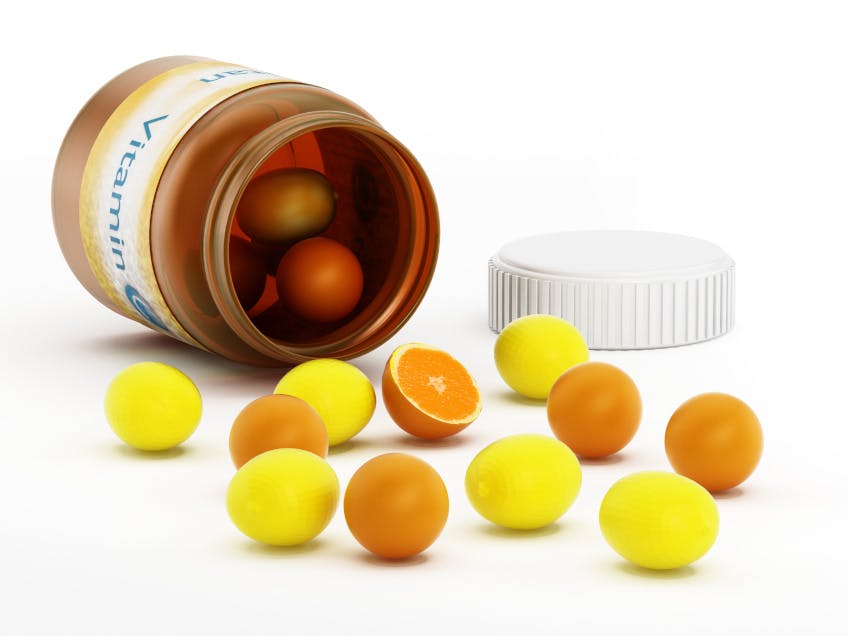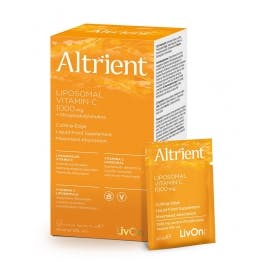What type of vitamin C supplement is best? By Dr Levy MD
A question that has been presented to me numerous times is "What kind of vitamin C should I take, and why?" It is a very good question, indeed. Let’s look at the different types of vitamin C that can be found in many of the capsules, powders and liquid vitamin C supplements available today…
It should first be emphasized that all of the forms of vitamin C share the characteristic of having a positively-charged cation and a negatively-charged anion, in the dissolved form. What all forms of vitamin C have in common is that they are all composed of an ascorbate anion. In fact, it is the ascorbate anion that is the electron-donating, active portion. It’s the ability of the ascorbate anion to bond with different types of cations that enables many different forms of vitamin C supplements to be produced. The most popular cations include various minerals and a fatty acid called palmitate. These companion cations also have significant biological impacts, and this needs to be considered when choosing the best form of vitamin C supplementation for both short-term and long-term needs.
Bowel Tolerance Factor
Vitamin C has pro’s and con’s when it comes to gut health. Each individual has their own ‘bowel tolerance’ level for vitamin C. This is the dose at which a vitamin C induced intestinal flush (diarrhoea) occurs. Individuals with a tendency towards gut issues are likely to have a lower bowel tolerance than those without a history of tummy troubles. If exceeding the bowel tolerance level is well-tolerated, then the remainder (un-absorbed) vitamin C passes into the colon before they get absorbed. Some forms of vitamin C supplements are more likely to trigger a lower bowel tolerance factor (ascorbic acid) whereas one of the benefits of liposomal vitamin C is that even at high doses digestive upset, diarrhoea or intestinal flushing is not a factor.
Ascorbic Acid
This is the cheapest, most regular form of vitamin C supplement available. But that does not mean that it’s the best form when it comes to absorption. Ascorbic acid is a desirable form of vitamin C to take if there is no concern with stomach upset. Since ascorbic acid is “acidic” then this form of vitamin C is often associated with a low bowel tolerance factor and when taken at mid to high doses commonly triggers stomach discomfort, stomach upset and an intestinal flushing. So, if you have a sensitive stomach, history of ulcer, colitis, IBS or any form of gut condition or inflammation then this is not a preferable form of vitamin C.
Mineral Ascorbates
The lion's share of all forms of vitamin C come as mineral ascorbates and the most common mineral ascorbates used in vitamin C supplementation include:
- Sodium ascorbate
- Calcium ascorbate
- Magnesium ascorbate
- Potassium ascorbate
- Manganese ascorbate
- Zinc ascorbate
- Molybdenum ascorbate
- Chromium ascorbate
Sodium Ascorbate
Sodium ascorbate is probably the best and certainly the least expensive of the mineral ascorbates for regular supplementation at relatively high doses. Sodium ascorbate is also the type of vitamin C that is used in liposomal vitamin C supplements. Sodium ascorbate is much kinder on the gut than ascorbic acid so it’s well-tolerated by individuals with stomach problems and digestive issues enabling higher bowel tolerance levels.
It should also be noted that large amounts of sodium ascorbate can be taken by those with high blood pressure and heart disease, without causing water retention or an increase in blood pressure. This is because it is sodium chloride, not sodium associated with an anion like ascorbate, citrate or bicarbonate, that reliably causes fluid retention and aggravates high blood pressure in individuals sensitive to volume overload. The term “sodium-dependent” hypertension should be replaced with “sodium chloride-dependent” or “table salt-dependent” hypertension.
However, since there always appear to be exceptions to every rule in biology, anyone who notices elevated blood pressure or ankle oedema after high doses of sodium ascorbate would be well-advised to supplement with a different form of vitamin C.
Calcium Ascorbate
Calcium ascorbate is slightly more expensive and is also marketed as "ester" or "buffered" vitamin C. Much of the popularity of this form of vitamin C comes from the fact that many people are looking for extra sources of calcium in addition to taking their vitamin C. These products typically deliver approximately 100mg of calcium for every 800 - 900mg of ascorbate. However, scientific data supports the concept that the vast majority of the older population is suffering from calcium toxicity. We continue to be stressed with warnings of increased risk of osteoporosis while the data clearly shows that most deaths in patients with osteoporosis relate to the vascular system and not the bones. The scientific evidence is very clear that supplemental calcium often fuels the progression of atherosclerosis, with the expected increased chance of heart attack. While it’s true that calcium ascorbate is easy on the stomach, sodium ascorbate is tolerated just as easily, is more affordable and does not aggravate calcium excess already present in most older individuals.
Magnesium Ascorbate
Magnesium ascorbate is an excellent form of vitamin C since it brings both magnesium and ascorbate into the body but it does come with a higher price tag. While there is nothing wrong with taking large amounts of magnesium ascorbate, it is more economical to take magnesium and sodium ascorbate separately and obtain the optimal effects of both these supplements.
Potassium Ascorbate
This is another good form of ascorbate supplementation but it does come with a potential health hazard since it is relatively easy to overdose on potassium which can cause fatal cardiac arrhythmias. Potassium should never be taken on a regular basis unless advised or prescribed by a healthcare practitioner.
Other mineral ascorbates
Manganese, zinc, molybdenum, and chromium ascorbates are additional mineral ascorbates which tend to be much more expensive. All of the cations are desirable as supplements, but they can be easily be overdosed if they are used to deliver multi-gram doses of ascorbate. Much more cost effective and safer to choose a sodium ascorbate instead.
Ascorbyl Palmitate
Ascorbyl palmitate is another form of vitamin C that is somewhat unique in that it has both water-soluble and fat-soluble qualities. This form of vitamin C is touted by some as a superior delivery of vitamin C than ascorbate. This has not really been clearly proven, and even if it were, ascorbyl palmitate would be a very expensive way to provide daily multi-gram doses of ascorbate. The fat-soluble qualities of ascorbyl palmitate do make it a good form of vitamin C to include in various skin creams and other dermatological preparations.
Liposome-encapsulated Ascorbate
One of the primary benefits of liposomal vitamin C is a near complete absorption of the encapsulated ascorbate into the bloodstream. The physical qualities of the liposome also eliminate the need for digestive activity before absorption and there is no intestinal flush effect with large doses. Furthermore, it appears to have a slower excretion rate and the highest absorption factor. The enhanced absorption along with the phospholipid dose absorbed has uniquely positive benefits and provides the best intracellular delivery of vitamin C.
My Current Recommendations
For regular daily supplementation, sodium ascorbate is an economical, well-tolerated form of vitamin C. For those wishing to have a near-complete absorption of their vitamin C dose, the liposomal encapsulated form of vitamin C is optimal.
Please note - This article was created and edited by Food Scientist and Nutritional Therapist Susie Debice using extracts from the book Death By Calcium and the article The Many Faces of Vitamin C, both by Dr Thomas Levy MD.
Bibliography
- Arad, Y., D. Newstein, F. Cadet, M. Roth, and A. Guerci (2001) Association of multiple risk factors and insulin resistance with increased prevalence of asymptomatic coronary artery disease by an electron-beam computed tomographic study. Arteriosclerosis, Thrombosis, and Vascular Biology 21(12):2051-2058.
- Bangham, A. (1995) Surrogate cells or Trojan horses. The discovery of liposomes. Bioessays 17(12):1081-1088.
- Christian, R., D. Dumesic, T. Behrenbeck, A. Oberg, P. Sheedy, and L. Fitzpatrick (2003) Prevalence and predictors of coronary artery calcification in women with polycystic ovary syndrome. The Journal of Clinical Endocrinology and Metabolism 88(6):2562-2568.
- Gregoriadis, G. (1995) Engineering liposomes for drug delivery: progress and problems. Trends in Biotechnology 13(12):527-537.
- Kiryu, S., V. Raptopoulos, J. Baptista, and H. Hatabu (2003) Increased prevalence of coronary artery calcification in patients with suspected pulmonary embolism. Academic Radiology 10(8):840-845.
- Kruger, M. and D. Horrobin (1997) Calcium metabolism, osteoporosis and essential fatty acids: a review. Progress in Lipid Research 36(2-3):131-151.
- Kurtz, T. and R. Morris, Jr. (1983) Dietary chloride as a determinant of "sodium-dependent" hypertension. Science 222(4628):1139-1141.
- Kurtz, T., H. Al-Bander, and R. Morris, Jr. (1987) "Salt-sensitive" essential hypertension in men. Is the sodium ion alone important? The New England Journal of Medicine 317(17):1043-1048.
- Raggi, P., B. Cooil, L. Shaw, J. Aboulhson, J. Takasu, M. Budoff, and T. Callister (2003) Progression of coronary calcium on serial electron beam tomographic scanning is greater in patients with future myocardial infarction. The American Journal of Cardiology 92(7):827-829.
- Shaw, L., P. Raggi, E. Schisterman, D. Berman, and T. Callister (2003) Prognostic value of cardiac risk factors and coronary artery calcium screening for all-cause mortality. Radiology 228(3):826-833.
- Tsugawa, N., T. Yamabe, A. Takeuchi, M. Kamao, K. Nakagawa, K. Nishijima, and T. Okano (1999) Intestinal absorption of calcium from calcium ascorbate in rats. Journal of Bone and Mineral Metabolism 17(1):30-36.
- Wong, N., M. Sciammarella, D. Polk, A. Gallagher, L. Miranda-Peats, B. Whitcomb, R. Hachamovitch, J. Friedman, S. Hayes, and D. Berman (2003) The metabolic syndrome, diabetes, and subclinical atherosclerosis assessed by coronary calcium. Journal of the American College of Cardiology 41(9):1547-1553.


.png?auto=format&q=45&w=262&trim=auto)
.jpg?auto=format&q=45&w=262&trim=auto)
.jpg?auto=format&q=45&w=262&trim=auto)